The first world war is one of the deadliest wars known to humans. Sixteen million people, including soldiers and civilians, lost their lives due to it.
Before the first world war, mutual alliances between different European countries existed.
The alliance between Germany, Austria-Hungary, and Italy was called the Triple Alliance.
The alliance between Britain, France, and Russia was called the Triple Entente.
Due to these alliances, what started as a war between two countries, Austria-Hungary and Serbia, became a European war.
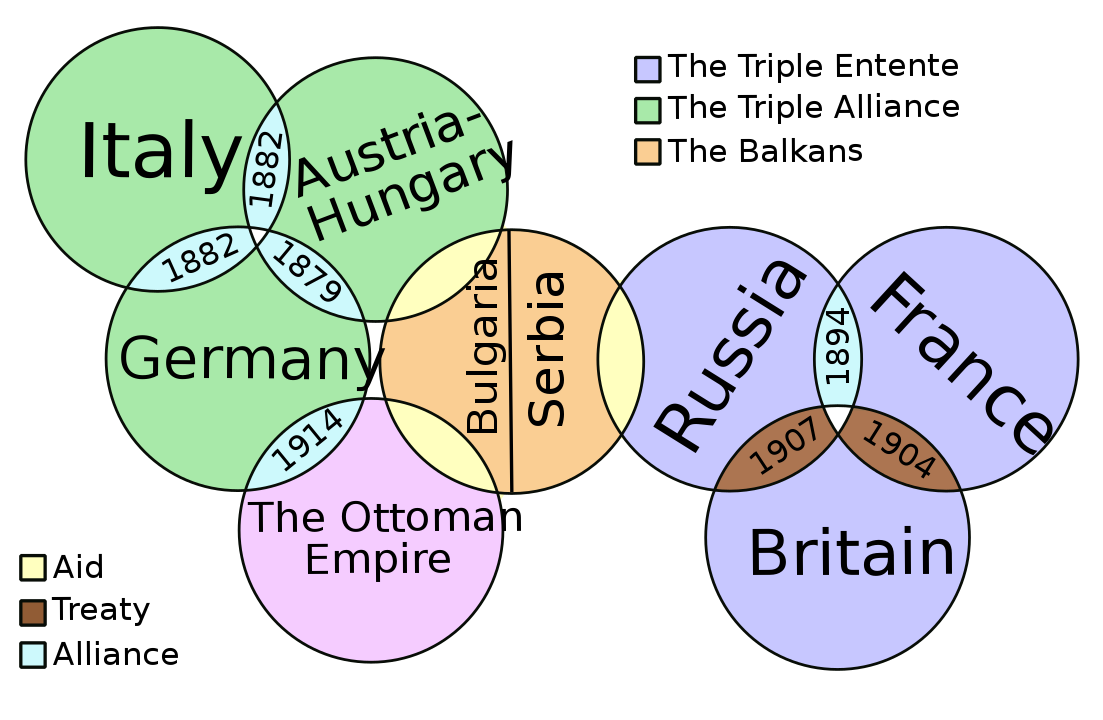
By It Is Me HereXiaphias – Derived from en:Image:WWIchartX.png, CC BY-SA 4.0, Link
Since every European country had colonies around the world, this transformed into a world war very soon.
This blog post explains how the first world war progressed, and how the various events that happened ultimately led to the Allied Forces’ victory.
Want to know what started the first world war? Read our blog post here: What started the first world war?
The two sides
The Allied forces fought the First world war against the Central forces.
The Allied forces consisted of Britain, France, Russia,Serbia, Italy, and the United States.
The Central forces consisted of Germany, Austria-Hungary, the Ottoman Empire, and Bulgaria.
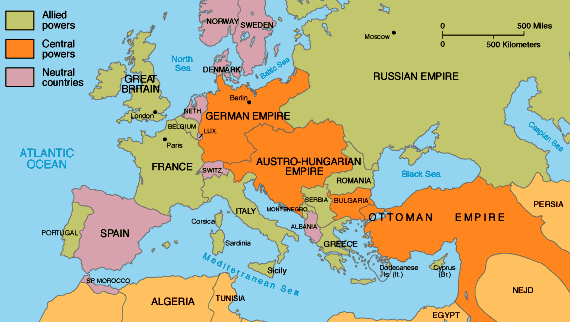
Picture credits
Let’s go back in time a little bit and see what happened.
For better understanding, the events that happened in the Central Powers are shown in Red and the events that happened in the Allied Forces are shown in Astronaut Blue color.
First world war begins
Austria-Hungary declares war on Serbia
On 28th July 1914, Austria-Hungary declares war on Serbia and shells the Serbian capital.
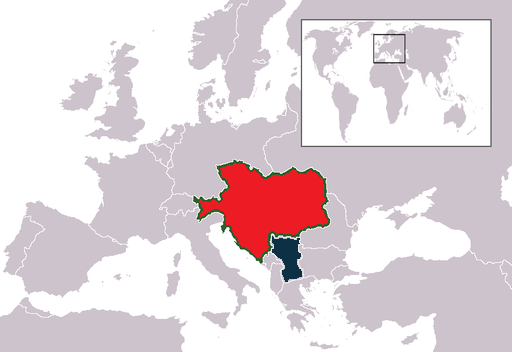
Picture credits – Cassini83 [Public domain]
Russia joins the war
In three days, Russia, Sebia’s ally, commands its military to mobilize in support of Serbia.
Germany joins the war
Germany, Austria-Hungary’s ally, asks Russia to demobilize within 12 hours. When Russia doesn’t comply, Germany declares war on Russia. Within a few days, Austria-Hungary declares war on Russia.
France joins the war
France, allied with Russia, mobilizes its troops in support of Russia.
Germany knows that it has to fight the war on two fronts – the eastern front against Russia and the western front against France.
Germany estimates that it would take six weeks for Russia to fully mobilize its troops. So, it follows the Schlieffen Plan to defeat France within six weeks before Russia can fully mobilize its troops.
As a result, Germany commits 80% of its troops to the western front against France. Germany hopes to defeat France quickly and bring its troops back to the eastern front against Russia.
According to the Schlieffen Plan, the Germany divides its armies in the western front into two parts. The southern army is to attack France on the West, while the northern army is to move through Belgium, then further South and finally attack France from the East in Paris.
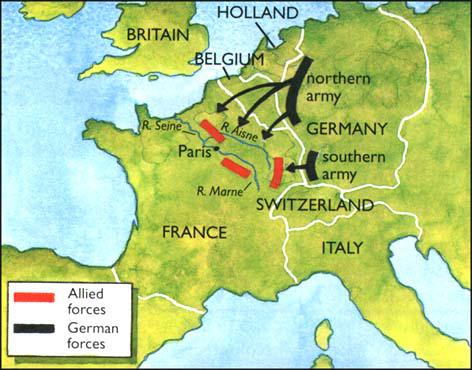
Illustration from Neil Demarco’s The Great War
Britain joins the war
To achieve this quick victory against France, Germany demands quick passage through neutral Belgium. When Belgium denies, Germany invades Belgium.
Belgium, Britain’s ally, seeks British help.
Germany’s invasion of neutral Belgium is an outrageous act of international-rights violation. Moreover, the invasion of France would mean German control of Western Europe as well as the English Channel. Due to these two reasons, Britain declares war on Germany on 4th August.
Since Japan is allied with Britain, within a month, Japan enters the war in favor of Britain.
The Western Front
After invading Belgium, German troops win decisive battles against British and French troops and advance rapidly into the French territory. In 35 days, they have advanced so much that Paris is just 30 miles from their reach.
Indeed, they have advanced so fast that they are faster than the supply of materials from Germany. As a result, they run out of Heavy artillery, which helped them win quick victories till now. This would put the Germans at a severe disadvantage in the next battle.
The first battle of Marne
German troops are divided into different groups called Armies.
According to the German plan of attack, the First and the Second armies are to move together. However, the General of the First Army, being optimistic, disobeys the order and chases a retreating French Army, creating a 30-mile gap between the Second army and himself.
The French forces learn of this opening with the help of their aircraft and intercepted German radio communications. The British and French troops launch a successful counterattack in this break in the German lines, thereby separating the German forces further and halting their advance.
This battle, the First Battle of Marne (5th – 12th September 1914), changes the course of the war altogether. A total of two million troops clash against each other.
It causes the German armies to retreat to the north of the Aisne River. The Allies and the Germans dig trenches on either side of the river.
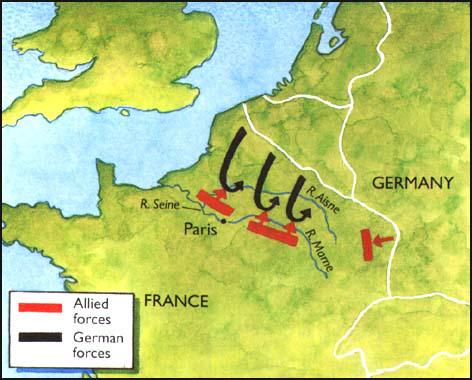
Illustration from Neil Demarco’s The Great War
What was supposed to be a quick victory on the West, becomes a battle that would drag on for the next three years.
Due to their strategic loss in the First Battle of Marne, the Germans are forced to fight battles on two fronts.
In the Western Front, both sides end up in a draw without achieving any significant victories for the time being.
The Western Front – Advantage : Nobody
The Eastern Front
In the Eastern front, Russia tries to mobilize its troops in support of France. However, it fails to mobilize completely. On 17th August, it sends only two of its armies without much support.
The Germans win the battle against the Russians. However, fearing further attacks, Germans transfer a part of their troops from the Western front to the Eastern front, which costs them the first battle of Marne.
The Eastern Front – Advantage : The Central Powers
The Italian Front
Italy enters the war
Since 1882 Italy has been allied with Germany and Austria-Hungary. But the alliance is only defensive, i.e., Italy should send its troops if Germany or Austria-Hungary is attacked.
However, Italy and Austria-Hungary have a complex relationship since they have similar interests in regions they want to add under their control. In 1908, Austria-Hungary annexes Bosnia and Herzegovina without providing Italy any regions. This upsets Italy.
So, when the world war begins, Italy refuses to send troops, indicating that Austria-Hungary is on the offensive. Therefore, it is not obliged to send any troops because the alliance is only defensive.
The Allies promise Italy the regions that it has interests on, once Austria-Hungary is defeated. So, it joins the war on the side of the Allies by declaring war on Austria-Hungary in May 1915.
For three years, it engages in deadly battles with the Austro-Hungarian and German forces in northern Italy and Slovenia.
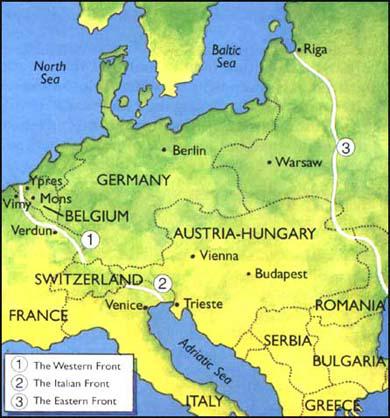
Picture credits
Even though neither side achieves a clear victory, the constant battles with Italy exhaust the Austro-Hungarian troops. It becomes one of the main reasons for the surrender of Austria-Hungary in November 1918.
The Italian Front : Advantage – Nobody
In the South
Balkans
Austria-Hungary hopes to win the war against Serbia quickly and then concentrate its forces against Russia.
However, in battles fought from 12th August 1914, Austria-Hungarian forces are pushed back. In one of the major upset victories of the 20th century, Serbia defeats the Austro-Hungarian invasion.
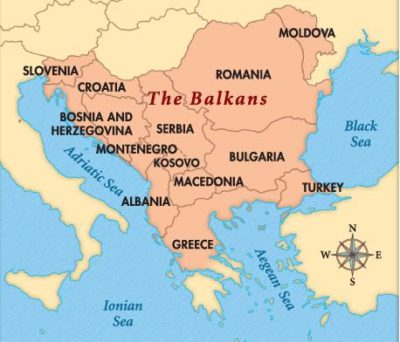
Please note that most of these countries were part of other empires during the first world war.
As a result, Austria-Hungary is forced to commit more troops against Serbia, and this weakens it against Russia.
Ottoman Empire enters the war
In November 1914, the Ottoman Empire enters the war in favor of Germany and Austria-Hungary.
The Ottoman Empire tries to take back its territories from Russia. It engages in bloody battles against the Allied forces in present-day Iran, Turkey, and Egypt.
In 1916, the Arabs, initiated by Britain, stage an uprising against the Ottoman Turks to create an independent Arab state. This revolt weakens the Ottoman Empire significantly.
Bulgaria enters the war
Serbia defeated Bulgaria in the Second Balkan war (1913). Therefore, Bulgaria enters the first world war on the side of the Central powers in October 1915.
Once Bulgaria joins the war, the winds shift in the sides of the Central Powers in the Balkans. Within a month, they defeat Serbia. Most of the Balkan region remains in the control of the Central Powers for another three years.
Balkans – Advantage : The Central Powers
The United States of America enters the war
The United States of America maintains a non-intervention policy in the war. However, it supplies weapons to the Allies.
In January 1917, Germany starts unrestricted submarine warfare (sinking ships without warning) to starve Britain. It ends up sinking US merchant ships as well.
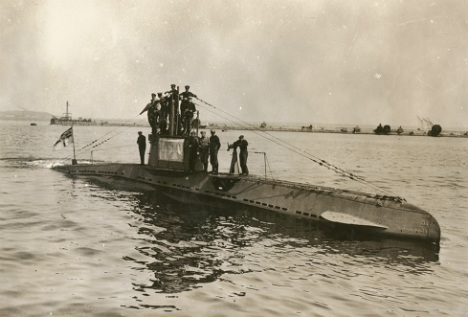
Picture credits
Food for thought: Why did Germany resort to unrestricted submarine warfare?
Normally, when submarines spot merchant ships or tankers, they have to surface, search the ships and escort the crew to safety before destroying them.
However, Britain created Q-boats, which are basically merchant ships that have disguised weapons. When submarines surface to search the Q-boats, they can destroy the submarines using their concealed weapons.
So, Germany resorted to unrestricted submarine warfare. In Unrestricted submarine warfare, the submarines sink the ships without warning when they sense one. This gives the crew no chance to escape.
As it expects the US to join the war, it sends a telegram to Mexico to start a war against the US. Britain intercepts this message and sends it to the US.
The sinking of the US merchant vessels and the controversial telegram push the US to declare war on Germany in April 1917.
The entry of the US changes the course of the first world war significantly.
The First world war ends
After resulting in millions of casualties, the war finally ends in 1918 with the surrender of the Central Powers.
The Eastern Front
Winner : The Central Powers
Due to its ineffective military leadership, Russia fails to take advantage of the few successes it has on the battlefield. As a result, the Central powers take over Poland in August 1915, and the Russian troops are forced to retreat.
Since the ruler of Russia remains in the military front, his German wife rules Russia. However, her rule is considered to be incompetent by the citizens. This leads to protests all over Russia. Soon, the emperor abdicates the throne.
Revolutions erupt in Russia, and the party headed by Vladimir Lenin becomes popular. His party wants to end the war. So, they sign a treaty in March 1918 that surrenders several regions to the Central Powers.
As a result, the Central Powers gain control of the Eastern Front.
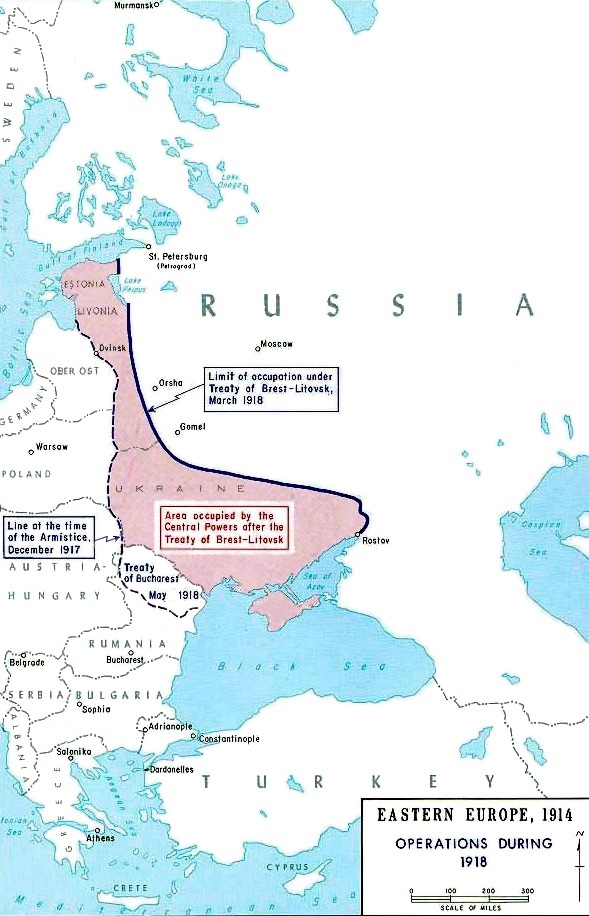
By Department of History, United States Military Academy – dean.usma.edu
Public Domain, Link
However, the Central Powers don’t have enough manpower needed to occupy the vast regions obtained from the treaty. So, their success in the Eastern Front doesn’t help them win the world war.
In the Balkans
Winner : The Allied Forces
Bulgaria surrenders
In September 1918, after most of the German and Austro-Hungarian troops have withdrawn, Serbian, French, and Greek troops attack a part of Serbia occupied by Bulgaria.
This battle, known as the Vardar Offensive, doesn’t cause many casualties. However, the Allied Forces’ use of heavy artilleries and combat aircraft destroy the morale of the Bulgarian troops.
As a result, Bulgaria signs a truce with Allied Powers on 29th September 1918, thereby demobilizing and disarming its troops.
The war now shifts in favor of the Allied Forces because they can move their troops through Bulgaria.
Bulgaria’s surrender affects Germany significantly because the Balkan peninsula is the main source of food and oil for the Central Powers.
On the other hand, the US is the major supplier of oil for the Allied Forces. In addition to that, the US has been sending fresh troops at the rate of 10,000/day.
Ottoman Empire surrenders
The Ottoman Empire has been at war with the combined forces of Britain, New Zealand, and Australia in the South.
Since March 1917, the Allied Forces start pushing Northeast, starting from Egypt.
They win battles against the Ottoman Empire and push steadily past Iran, Jordan, up to Syria. They capture the headquarters of several armies of the Ottoman Empire on the way.
Due to the surrender of Bulgaria, the British and Greeks send their troops to Turkey through Bulgaria.
Since the Ottoman Turks don’t have enough troops to fight them, they sign a truce on 30th October with the Allied Forces.
The Italian Front
Winner : The Allied Forces
Austria-Hungary surrenders
Austria-Hungary has been fighting deadly battles against Italy in Northeastern Italy and Slovenia.
In 1917, in a battle that lasts 17 days, Italy suffers 300,000 casualties.
So, Italy orders the commissioning of all Italian boys older than 18 in the army. By using advance defense techniques, Italy is able to stop the advance of Austria-Hungary.
In June 1918, Austria-Hungary launches a major offensive to deal a decisive blow to Italy. However, this ends in a defeat for Austria-Hungary.
Italy launches an attack on 24th October to cut off Austro-Hungarian supplies and retake the Italian mountains and cities.
Italy wins the battle, partly because the Austro-Hungarian troops refuse to obey their commander’s order to counterattack. It captures around 350,000 Austro-Hungarian troops.
At the same time, Austria-Hungary starts to disintegrate at home, when people of different ethnicities start demanding separate nations.
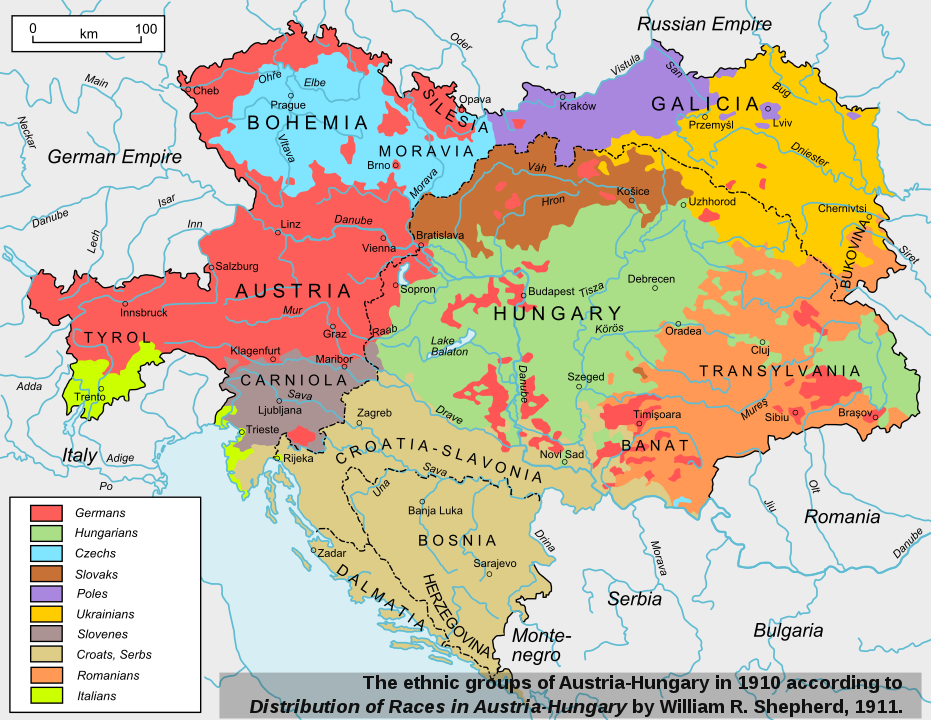
By Andrein – Transferred from en.wikipedia to Commons., Public Domain, Link
So, Austria-Hungary signs a truce with the Allied Forces on 3rd November 1918 and grants free passage to Germany.
The Western Front
Winner : The Allied Forces
Germany surrenders
To capture the Western Front before reinforcements from the United States arrive, Germany launches the Spring offensive of 1918.
Using the element of surprise, ingenious infiltration tactics, and specially trained units, German troops penetrate the British and French trenches. They push rapidly. However, due to the difficulty of transporting materials and artillery over rugged terrain, their success is only short-lived.
Over the next few months, Germany launches attacks to break the British and French lines. However, none of them is successful.
In return, the Allied Forces launch the Hundred days offensive, which is a series of attacks against the German lines in the Western Front that push Germany back.
At the same time, Germany also suffers at home, due to the frequent anti-war marches. This has a terrible effect on the German troops’ morale.
German navy troops refuse to sail to make one last stand, initiating the German revolution. Facing defeat abroad and at home, King Wilhelm II flees the country, and Germany becomes a republic (Weimar Republic).
The new government signs a truce on 11th November 1918 and the First world war finally ends.
Treaty of Versailles
The countries of the Central Powers signed peace treaties once the world war ended. The most important of these is the Treaty of Versailles, which was signed by Germany.
Article 231, which made Germany guilty of the damage caused, required it to disarm and pay reparations to the countries of the Allied Forces amounting to 132 Billion Marks ( $31.4 Billion then).
This article, considered too harsh, led to the discontent for the Weimar Republic and contributed to the rise of Nazism, which would ultimately lead to the second world war.
If you liked reading this blog post, you may also like the next blog post: The aftermath of world war 1.

Leave a Reply